Scottish Aggregates Levy: evidence review and policy options
Research reviewing, modelling and analysing illustrative options for a Scottish specific Aggregate Levy.
Illustrative Impacts from Changes to the Levy
This section presents the results of some scenario modelling for the selected illustrative policy options. The illustrative policy options are included purely to show the various financial and environmental outcomes of a broad range of policies. They should not be seen as indications of policy intent regarding the setting of the Scottish Aggregates Levy. The data generated is also illustrative in the sense that the independent Scottish Fiscal Commission (SFC) would ultimately be forecasting revenue and policy costings for the Scottish Aggregates Levy and they will model the devolution of the tax based on the information they have available to them at the time of their first revenue forecast. Comparison between policy options are presented in terms of changes from the BaU outputs for the final modelling year, 2030. This particular year was chosen simply to observe long-term projections and the effects of tax policy. This work therefore goes beyond the 5-year forecasts normally presented by SFC.
Aggregates Production, Import and Export
Figure 15 presents the change in domestic production, import, export and primary demand for crushed rock. Under Option 4 the change in significantly smaller than the change under other options, because the levy rate is kept constant under this option. On the other hand, the highest level of change is observed under Option 3, where the levy rate is set to zero. Option 1 displays an overall reduction in total demand for crushed rock due to an increase in the levy rate, while Option 2 displays an overall increase in total demand for crushed rock due to a reduction in the levy rate. It can also be observed that, there are very little changes in imports as a response to change in levy rates, which is consistent with import figures for presented in Table 16 (Appendix 6).
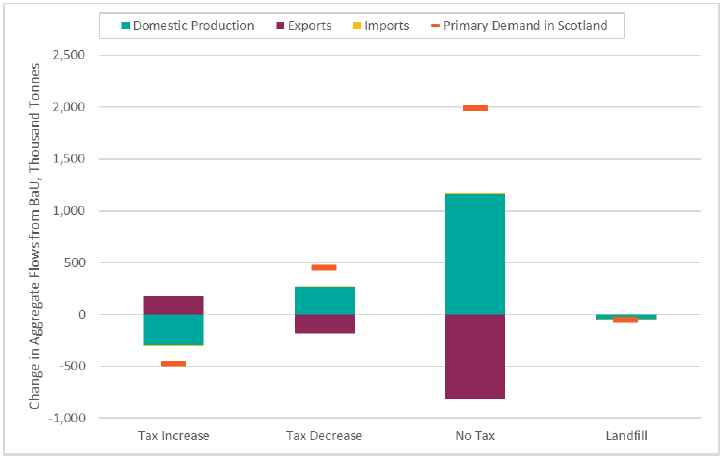
Similarly, changes in domestic production, exports, imports and primary demand for sand and gravel can be observed in Figure 16, although there are very small changes in cross border flows of sand and gravel under all four options.
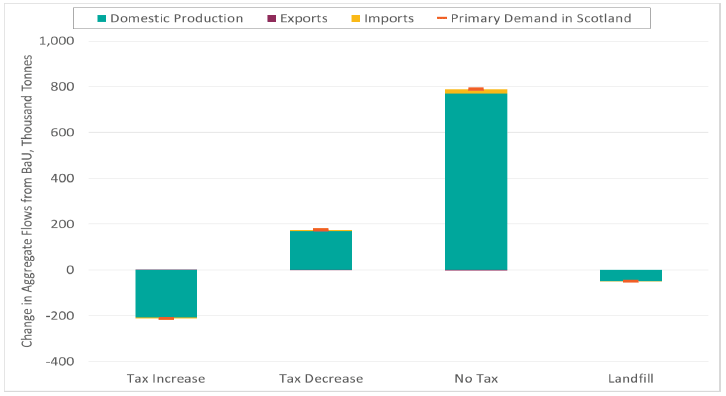
Figure 17 presents the change in total primary aggregates - crushed rock and sand and gravel - production, import, export, recycling and total demand under different options. As before, Option 3 displays the highest level of change, whereas Option 1 displays an overall reduction in demand for primary aggregates due to the increase in levy rate. Similarly, Option 2 displays an overall increase in primary demand due to the reduction in levy rate.
Moreover, Option 1 and Option 4 generates the highest level of recycling, due to an increase in aggregates levy or introduction of a new banding in landfill tax rates related to aggregates (e.g. inert rate), respectively.
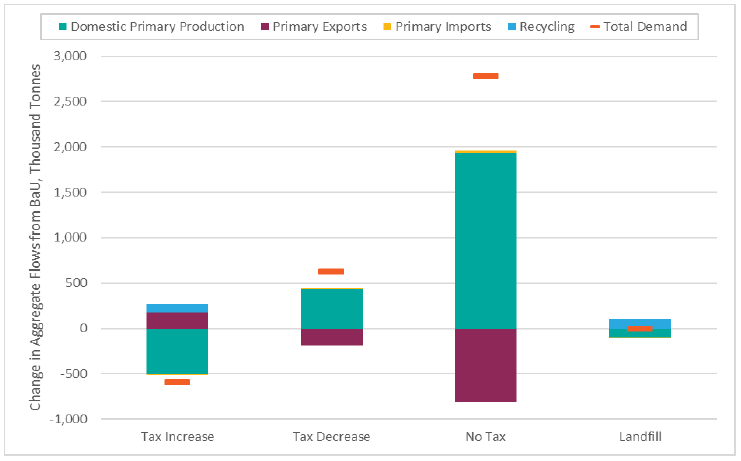
Finally, Figure 18 presents the change in domestic production of primary aggregates in Scotland. An overall decreasing trend is observed under all four options as well as the BaU scenario, although domestic production increases significantly in the beginning under Option 3, due to a large increase in demand in the absence of the levy.
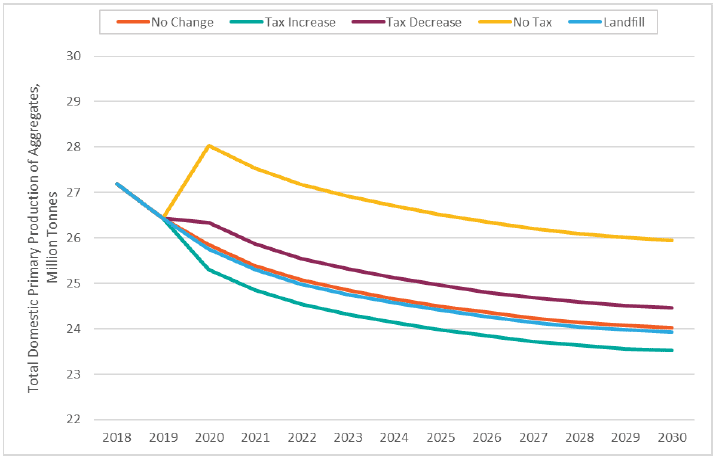
Production of Secondary Aggregates
Production of secondary aggregates and C&D waste recycling rates are presented in Figure 19. It can be observed that the highest amounts of recycled aggregates are produced under Option 1 and Option 4, with the C&D waste recycling rate of 95%. On the other hand, for Options 2 and 3, there is no change in the production of recycled aggregates from BaU, due to lack of incentives to recycle C&D waste further.
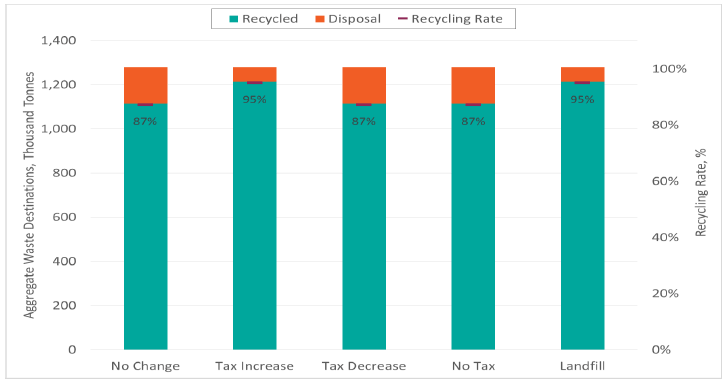
Aggregates Levy Revenue
Levy revenues generated under different options are presented in Figure 20. It can be observed that only Option 1 generates higher levy revenue compared to the levy revenue generated under the BaU scenario. It can also be observed that Option 4 generates slightly lower levy revenue compared to BaU. This is because, under this option increase in production of recycled aggregates is offset by the reduction in primary production and import to keep demand constant, resulting in a slight reduction in levy revenue compared to the BaU scenario.
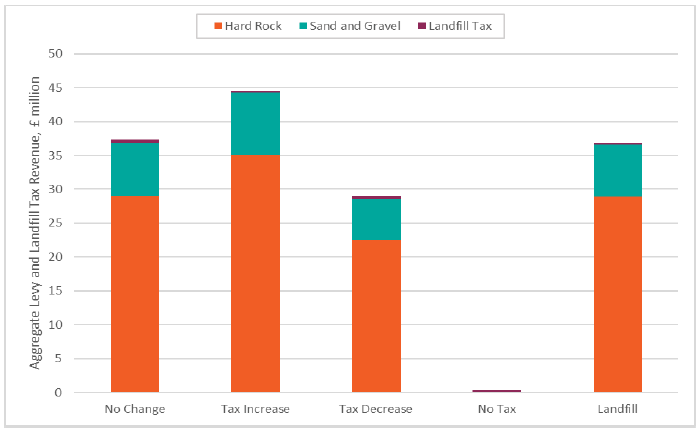
Figure 21 presents the change in levy revenue over time under all 4 options as well as the BaU scenario. Due to the reduction in demand for primary aggregates over time, levy revenue depicts a downward trend under all 4 options as well as the BaU scenario.
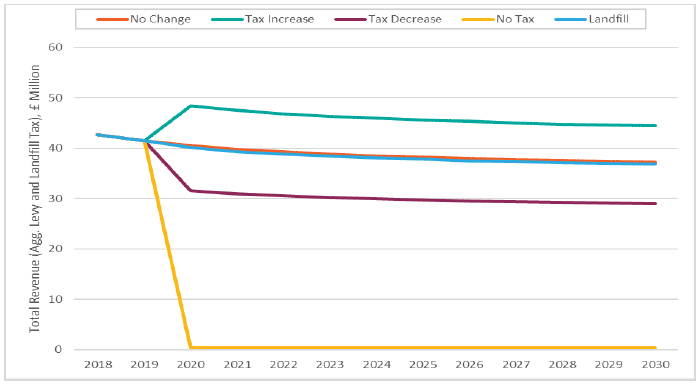
Externality Costs of Aggregates Production
Externality costs of aggregates extraction and transportation[61] under different options along with the BaU scenario are presented in Figure 22. Due to increases in domestic production of aggregates, the greatest increase in externality costs occur under Option 3 (No Tax). Option 1 (Tax Increase) generates the lowest amount of externality costs, followed by Option 4 (Landfill), both of which generating externality costs below the BaU scenario. Finally, Option 2 (Tax Decrease has slightly higher externality costs compared to BaU, given the net increase in primary production under Option 2 as compared to the BaU scenario.
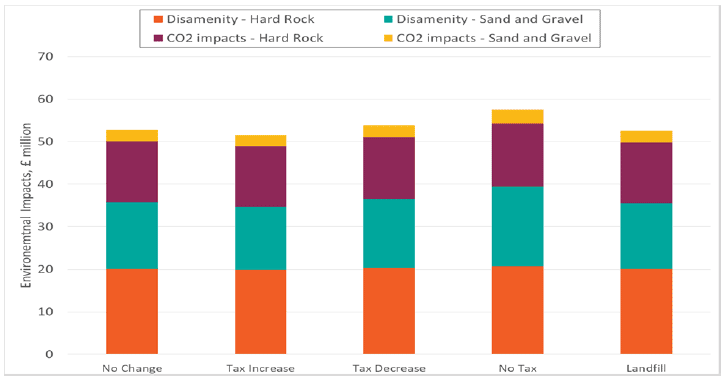
Figure 23 presents the change in externality costs over time for the period 2018 to 2030. It can be observed that, for all options as well as the BaU scenario, the overall externality costs increase over time, even though the production of primary aggregates decreases over time. As shown in Appendix 3, externality cost per tonne of aggregates production and transportation increase over time due to:
- Increase in willingness to pay with increase in income over time; and
- Increase in shadow price of carbon over time.
Therefore, when the unit externality cost increases at a faster rate than the rate of decrease of primary aggregates production, the total externality cost associated with primary aggregates production and transportation also increases over time.
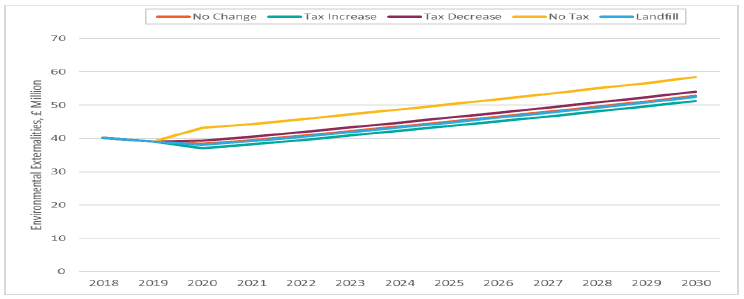
Discussion of the results
Summary of the results for all 4 options in terms of difference from the BaU scenario for 2030 are presented in Table 4.
| Option 1 Relative tax increase scenario | Option 2 Relative tax decrease scenario | Option 3 No tax scenario | Option 4 New landfill tax band for aggregates | |
|---|---|---|---|---|
| Aggregates Flows (000 tonnes) | ||||
| Domestic production | -505 | 435 | 1928 | -97 |
| Exports (see footnote 85) | 175 | -186 | -814 | 0 |
| Imports (see footnote 85) | -9 | 7 | 32 | -2 |
| Total demand | -590 | 627 | 2775 | 0 |
| Recycled aggregates | 99 | 0 | 0 | 99 |
| C&D waste recycling rate (%) | 8% | 0% | 0% | 8% |
| Revenue (£ million) | ||||
| Aggregates levy revenue | 7.5 | -8.3 | -36.8 | -0.2 |
| Landfill tax revenue | -0.3 | 0 | 0 | -0.2 |
| Externality Costs (£ million) | ||||
| Disamenity costs | -1.1 | 1 | 4.3 | -0.2 |
| Climate Change Impacts (CO2 Emissions) | -0.3 | 0.3 | 1.4 | 0.0 |
| Total externality costs | -1.4 | 1.3 | 5.7 | -0.2 |
The above illustrative analysis suggest that both Option 1 and Option 4 would generate the highest level of recycled aggregates production. However, Option 1 would also generate significantly higher levy revenue and has lower externality costs compared to the BaU scenario and all other options. So if the objective is to maximise levy revenue and/or to reduce the external costs of aggregates extraction in Scotland along with increasing the production of recycled aggregates, Option 1 seems to be the preferred option.
However, it should be noted that the amount of additional recycling generated through change in the Scottish Aggregates levy or by introducing a new landfill tax band for aggregates may be very small, given that approximately 87% of the C&D wastes are currently being recycled under the BaU scenario.
Moreover, increasing recycling of C&D waste through introduction of a new landfill tax band for aggregates, will require additional monitoring and enforcement, which will increase the implementation costs of such a measure. In addition, various provisions for the exemption of C&D wastes from the landfill tax will need to be revised to ensure that C&D wastes are recycled to the highest quality possible for using as a substitute of primary aggregates rather than other low value uses, such as, pipe bedding or backfilling.
Contact
Email: robert.souter@gov.scot
There is a problem
Thanks for your feedback